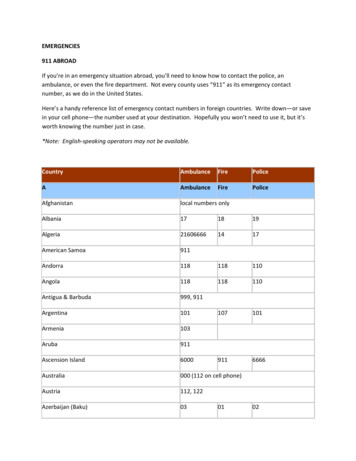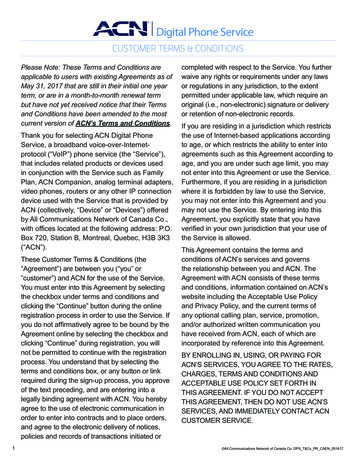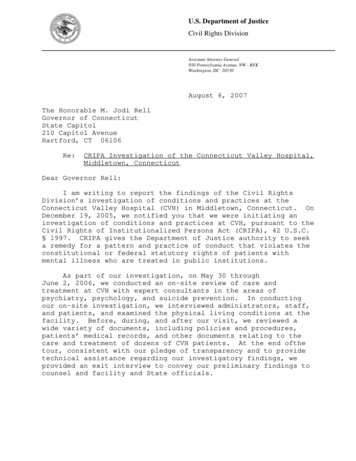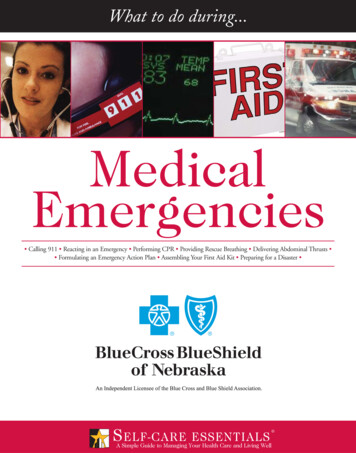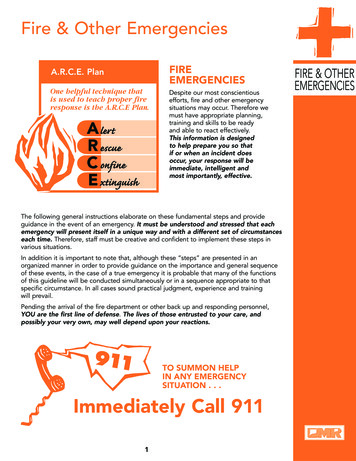
Transcription
Fire & Other EmergenciesA.R.C.E. PlanFIREEMERGENCIESOne helpful technique thatis used to teach proper fireresponse is the A.R.C.E Plan.Despite our most conscientiousefforts, fire and other emergencysituations may occur. Therefore wemust have appropriate planning,training and skills to be readyand able to react effectively.This information is designedto help prepare you so thatif or when an incident doesoccur, your response will beimmediate, intelligent andmost importantly, effective.A lertR escueC onfineE xtinguishThe following general instructions elaborate on these fundamental steps and provideguidance in the event of an emergency. It must be understood and stressed that eachemergency will present itself in a unique way and with a different set of circumstanceseach time. Therefore, staff must be creative and confident to implement these steps invarious situations.In addition it is important to note that, although these “steps” are presented in anorganized manner in order to provide guidance on the importance and general sequenceof these events, in the case of a true emergency it is probable that many of the functionsof this guideline will be conducted simultaneously or in a sequence appropriate to thatspecific circumstance. In all cases sound practical judgment, experience and trainingwill prevail.Pending the arrival of the fire department or other back up and responding personnel,YOU are the first line of defense. The lives of those entrusted to your care, andpossibly your very own, may well depend upon your reactions.911TO SUMMON HELPIN ANY EMERGENCYSITUATION . . .Immediately Call 9111FIRE & OTHEREMERGENCIES
Dealing with Fire EmergenciesThe following protocol is operative throughout the Department of Mental Retardation for all FireEmergencies (e.g., fire, smoke, odor of smoke or burning, crackling noises, unusual heat conditions, andany automatic detector activation). Although specifically geared to “fire” type emergencies much of itwould apply in any generalized emergency situation. In addition, following this section on dealing withfire emergencies, there is some specific guidance for dealing with other potential emergencies.A lert DO NOT PANIC – remain calm. Do not shout or yell. YOUR FIRST CONCERN IS FOR LIFE SAFETY – thesafety of the people you support, yourself and othersis of paramount importance. ALERT EVERYONE NEARBY. PULL THE NEAREST ALARM BOX IF AVAILABLE.This will automatically notify building occupants, theFire Department and additional help. In addition thismay initiate automatic fire protection features of thebuilding. CALL 911 – IF NO FIRE ALARM IS AVAILABLE, IMMEDIATELY CALL 911.If there is an alarm system available, make a back-up call to 911, as soon aseveryone is in a point of safety. Although redundant, this assures responseand provides additional information to the responders.Give the dispatcher the following information:– your name– location – brief description of the incident.Answer all questions. Prepare to follow instructions, and do not hang upuntil directed by the dispatcher.R emoveEVACUATE EVERYONE TO A POINT OF SAFETY. All occupants should beevacuated as quickly and as orderly as possible to a pre-designated Point ofSafety, using the following guidelines: As a general rule, the method that is employed under non-emergencysituations is going to be the best method for movement under emergencysituations. (e.g., self-ambulating, assistance, wheelchair, etc.) In addition,consideration should be given to: what is the safest and most efficient methodto evacuate this individual in this specific emergency situation? Anyone in immediate danger should utilize the nearest and most immediateexit. At any time there is evacuation to the outside of the building, theevacuation should be to a pre-determined Point of Safety. As soon as alloccupants are gathered in a safe place (either within the building, in an area ofrefuge, or outside), take a roll call. If anyone is missing, immediately report thisto the first arriving fire personnel. If you are trapped by smoke or fire: close doors, stay low, block openingsto room and open a window to attract attention of rescuers.C onfine CONFINE THE FIRE by closing any doors, fire doors and other openings intothe room or area of origin. CLOSING A DOOR can be a very simple and effective method of containingthe fire, buying time for evacuation.2
E xtinguishEXTINGUISH THE FIRE. Attempt to extinguish the fire only after everyone is at apoint of safety (unless extinguishment of the fire is needed to evacuate, i.e. fire isbetween you and the door). Attempt to extinguish the fire only if you are trained,and it is appropriate to the circumstance.Fire Emergencies General Information ALL AUTOMATIC ALARMS should be treated as TRUE EMERGENCIES.You should immediately begin an evacuation as outlined above, regardlessof the cause of the automatic alarm or where you are whenit occurs. BEDS, MATTRESSES AND OTHER BULKY EQUIPMENT should NEVER beused to evacuate anyone unless absolutely necessary. (Use blanket drags,carries, etc.) STAY LOW. Keep yourself and others low if in a smoke involvedarea. The fire generated smoke and gases are potentially moredangerous than the actual flames. ELEVATORS SHOULD NEVER BE USED DURING A FIRE or emergencysituation, other than by firefighting personnel. NO ONE, OTHER THAN FIREFIGHTING PERSONNEL, should ever enter orre-enter a fire or smoke-involved building. BASED ON YOUR TRAINING AND/OR YOUR RESPONSIBILITY, you mayneed to re-enter areas that are not involved with fire or smoke to assist thosedependent on your support. Use your training and caution if necessary to dothis. If re-entry is required, make someone aware of your actions to provideaccountability for arriving emergency responders. REPORT ANY FIRE TO THE FIRE DEPARTMENT IMMEDIATELY, even if itappears to be out, or you don't think it's significant.Other Emergencies General Instructions REMAIN CALM – you are responsible for the people you support, yourself and others. RESPOND TO ALL IMMINENT DANGERS APPROPRIATELY. Evacuate unsafe or potentially unsafeareas and / or buildings. STAY TUNED TO RADIO AND TELEVISION REPORTS FORUPDATES AND INFORMATION. Information will be disseminatedas appropriate. WHENEVER NEEDED CALL 9-1-1 TO OBTAIN HELP FOR ANYEMERGENCY. Appropriate help and assistance will be dispatchedimmediately to your location. NO PLAN CAN PREPARE FOR ALL POSSIBILITIES – eachemergency will present itself in a unique way and with a differentset of circumstances. These guidelines are designed to give guidancefor what to do in the event of an emergency and to provide a soundfoundation for training.3
Hurricanes and EarthquakesFlooding KNOW THE TERMS USED TO DESCRIBESEVERE WEATHER THREATS:A Hurricane Watch means that such a storm ispossible, A Hurricane Warning means that sucha storm is expected in the area. THE SAFEST PLACE TO RELOCATE IS HIGHERFLOORS OR LEVELS. BE AWARE IF YOUR LOCATION is in a low-lyingarea or flood plain. IN THE EVENT OF MINOR FLOODING, stay inyour location, unless the building's systems (e.g.,furnaces, etc.) are threatened. MOVE EVERYONE AWAY FROM GLASS DOORSAND WINDOWS. MOVE TO AN INTERIOR PORTION OF THEBUILDING, if possible (i.e., the center halls.) IN THE EVENT OF WIDESPREAD FLOODING,prepare for extended evacuation. CLOSE ALL BLINDS, DRAPES, ETC. to preventflying glass.Severe Cold Weather BE ORDERLY AND REASSURING. Maintain thenormal routine as much as possible. WIND CHILL TEMPERATURES BELOW25 DEGREES pose increasing danger andprecautions should be taken.Tornadoes EVERYONE SHOULD BE DRESSED FORADEQUATE WARMTH, closelymonitored and kept in heatedlocations during all coldweather. KNOW THE TERMS USED TO DESCRIBESEVERE WEATHER THREATS: A Tornado Watchmeans that such a storm is possible, A TornadoWarning means that such a storm has beensighted or is imminent. THE SAFEST PLACE TO RELOCATE INSIDE ABUILDING IS NEAR WALLS, in the corners of thebasement.Severe Hot Weather HIGH TEMPERATUREWEATHER THAT IS OVER 85DEGREES, especially with highhumidity over 70%, poses increasingdanger and precautions should be taken. IF A WARNING IS RECEIVED, everyone shouldimmediately move to a central location and beprepared to quickly relocate to the basement ifpossible. EXTREME HIGH TEMPERATURE WEATHERIS DEFINED AS any day in which the ambienttemperature is over 90 degrees, with highhumidity. OPEN ALL WINDOWS 2-3” AND CLOSE ALLBLINDS to prevent flying glass. Windows can betaped if enough warning is given WHEN A WARNING OR CONDITIONS DICTATE,immediately move everyone to the basement. IN HOT WEATHER, check to make sure that alldrapes are drawn to stop sunlight, all coolingappliances are operating (air conditioning andfans), and that everyone is appropriately dressed. MOVING NONAMBULATORY PEOPLE to thebasement shall be handled as in any otherevacuation process. TAKE APPROPRIATE PRECAUTIONS such asmaking sure people drink extra fluids to avoiddehydration, move to cooler areas, avoidstrenuous activities etc. IF YOU ARE IN A BUILDING WHICH DOESNOT HAVE A BASEMENT, or the basement isinaccessible, move to an interior room on thelowest level possible.4
Radiological Disasters ANYONE WITHIN THE 10 MILE EMERGENCYPLANNING ZONE (EPZ) of the Millstone NuclearPower Plant should be aware of their localemergency relocation plans, warning systemsand methods of the Relocation Planning Zone. CHECK THE DEPARTMENT OF MENTALRETARDATION SPECIAL OPERATIONS PLANor contact your Local Emergency PlanningCommission for details.Emergency Evacuations CONSIDER PREPARING INDIVIDUALEVACUATION CHECKLISTS includingunique necessities such as criticalmedications, glasses, etc., asrecommended by the FederalEmergency ManagementAgency or the American RedCross. FURTHER EVACUATIONS AS DEEMEDNECESSARY by the Fire Officer in charge shallbe so ordered and carried out as necessary. IN NO CASE SHOULD ANYONE ENTER OR REENTER AN UNSAFE OR TOXIC ATMOSPHERE –immediately report to incoming fire personnelanyone who is unaccounted for.Carbon Monoxide Emergencies IT IS RECOMMENDED, that all areas wherethere is a potential source of carbon monoxide(e.g., furnaces) should have carbon monoxidedetectors installed.EVACUATEHazardous MaterialEmergencies IN THE EVENT OF ANY LEAKOR SPILL OF HAZARDOUSMATERIALS that creates animmediate or imminent danger,everyone should be evacuated to aPoint of Safety. This will usually be anarea away from the building and upwind. IN ANY CASE WHERE A CARBONMONOXIDE DETECTOR SOUNDS oryou are concerned that there may bebuild up of carbon monoxide presentdue to symptoms (see below), everyoneshould be evacuated. CARBON MONOXIDE POISONINGHAS MANY SYMPTOMS – someare very similar to flu symptoms.Symptoms may include but are notlimited to: – headaches – nausea– vomiting – fatigueSymptoms can come on in a shortperiod of time or be present for alonger time. Prolonged exposuremay result in severe symptoms suchas unconsciousness, convulsionsand death. CALL 9-1-1 and give a brief descriptionof the emergency. EVACUATION TO THE OUTSIDE is generally thebest action to take. YOUR LOCAL FIRE DEPARTMENT WILLRESPOND PROMPTLY and evaluate theemergency and shall implement its plan fordealing with Hazardous Materials incidents. FROM A POINT OF SAFETY – immediatelycall 9-1-1 to report the problem.Published by: CT Department of Mental Retardation, 460 Capitol Avenue, Hartford, CT 06106
Agency or the American Red Cross. Hazardous Material Emergencies IN THE EVENT OF ANY LEAK OR SPILL OF HAZARDOUS MATERIALS that creates an immediate or imminent danger, everyone should be evacuated to a Point of Safety.This will usually be an area away from the building and upwind. CALL 9-1-1 and give a brief description of the emergency.

